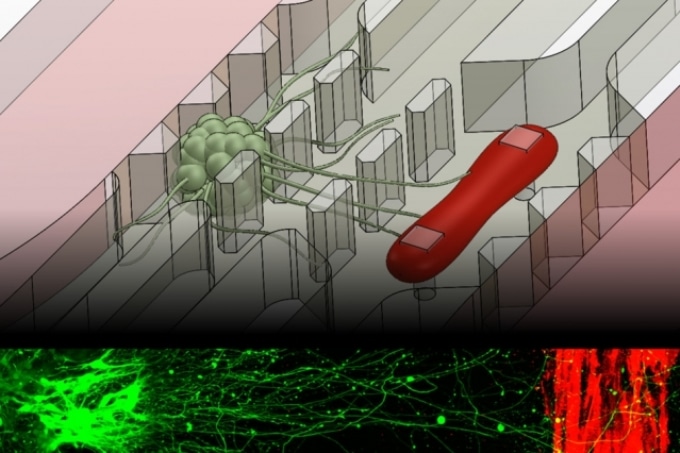Aug 5 2016
 A new microfluidic device that replicates the neuromuscular junction — the vital connection where nerve meets muscle — contains a small cluster of neurons (green) and a single muscle fiber (red). A fluorescence image, bottom, shows the motor neurons sending out axons toward a muscle strip over a distance of about 1 millimeter. (Image: Sebastien Uzel)
A new microfluidic device that replicates the neuromuscular junction — the vital connection where nerve meets muscle — contains a small cluster of neurons (green) and a single muscle fiber (red). A fluorescence image, bottom, shows the motor neurons sending out axons toward a muscle strip over a distance of about 1 millimeter. (Image: Sebastien Uzel)
MIT researchers have designed a microfluidic device that mimics the neuromuscular junction, the place where muscle and nerve meet.
The device is nearly the size of a U.S quarter and includes a single muscle strip and a small group of motor neurons. Scientists can easily observe and control the interactions between the two inside a realistic, three-dimensional matrix.
The scientists genetically altered the neurons inside the device to reply to light, and they accurately stimulated the neurons by shining light directly on these cells that send signals to stimulate the muscle fiber. They also assessed the pressure the muscle exerts inside the device because it contracts or twitches in reaction.
The study results are published online in Science Advances. The findings could help researchers to understand and identify potential drugs to treat amyotrophic lateral sclerosis (ALS), also called Lou Gehrig’s disease, and other neuromuscular-related conditions.
The neuromuscular junction is involved in a lot of very incapacitating, sometimes brutal and fatal disorders, for which a lot has yet to be discovered. The hope is, being able to form neuromuscular junctions in vitro will help us understand how certain diseases function.
Sebastien Uzel, Former Graduate Student, MIT
In addition to Uzel the coauthors include Roger Kamm, the Cecil and Ida Green Distinguished Professor of Mechanical and Biological Engineering at MIT, former graduate student and now postdoc Randall Platt, former undergraduate researcher Taylor Pearl, research scientist Vidya Subramanian, former postdoc Vincent Chan, senior postdoc Christopher Rowlands, professor of mechanical engineering and biological engineering Peter So, and associate professor of biology Laurie Boyer.
Closing in on a Counterpart
Since the 1970s, scientists have created numerous methods to simulate the neuromuscular junction inside the laboratory.
Most of these experiments require producing muscle and nerve cells in thin Petri dishes or on tiny glass substrates. However, such settings are far in the body, where muscles and neurons reside in complex, three-dimensional conditions, repeatedly separated over lengthy distances.
Think of a giraffe, neurons that live in the spinal cord send axons across very large distances to connect with muscles in the leg.
Sebastien Uzel, Former Graduate Student, MIT
Uzel and his colleagues developed a microfluidic device to rebuild more realistic in vitro neuromuscular junctions. The device features a three-dimensional environment as well as chambers that separate both muscles and nerves in order to replicate their natural separation within the body.
The scientists suspended both the muscle and neuron cells inside the millimeter-sized chambers that they subsequently filled it with gel to imitate a three-dimensional environment.
A Flash and a Twitch
In order to develop a muscle fiber, the researchers used muscle precursor cells acquired from mice and differentiated that into muscle cells. Then they inserted the cells into the microfluidic chamber, where the muscle cells and the nerve cells grew and fused into a single muscle strip.
In the same way, the researchers separated motor neurons from a group of stem cells and positioned the resulting collection of neural cells in the second chamber. Before separating both cells, the scientists used a common method known as optogenetics to genetically modify the neural cells to reply to light.
Kamm states light “gives you pinpoint control of what cells you want to activate,” instead of using electrodes, which, in such a limited space, can unintentionally stimulate cells excluding the targeted neural cells.
Finally, the scientists added another feature known as force sensing to the device. In order to assess the muscle contraction, they produced two small, flexible pillars inside the chamber of muscle cells, around which the developing muscle fiber could wrap, in order to assess the muscle contraction.
When the muscle contracts, the pillars inside the chamber squeeze together and create a displacement that can be measured and changed into mechanical force.
In order to check the device, Uzel and his co-workers at first noticed neurons stretching axons toward the muscle fiber inside the three-dimensional environment. Once they noticed that the axon had successfully made a connection, they stimulated the neuron with a small burst of blue light and directly noticed a muscle contraction.
“You flash a light, you get a twitch,” Kamm says.
Judging from all these experiments, Kamm states that the microfluidic device could be successfully used for testing drugs to treat neuromuscular disorders, and could also be modified to individual patients.
You could potentially take pluripotent cells from an ALS patient, differentiate them into muscle and nerve cells, and make the whole system for that particular patient. Then you could replicate it as many times as you want, and try different drugs or combinations of therapies to see which is most effective in improving the connection between nerves and muscles.
Rodger Kamm, Professor, MIT
Kamm states that the device could also be of use in “modeling exercise protocols.” For example, researchers can examine how repeated stress influences muscle performance by stimulating muscle fibers at different frequencies.
“Now with all these new microfluidic approaches people are developing, you can start to model more complex systems with neurons and muscles,” Kamm says. “The neuromuscular junction is another unit people can now incorporate into those testing modalities.”
This research work was partly funded by the National Science Foundation.